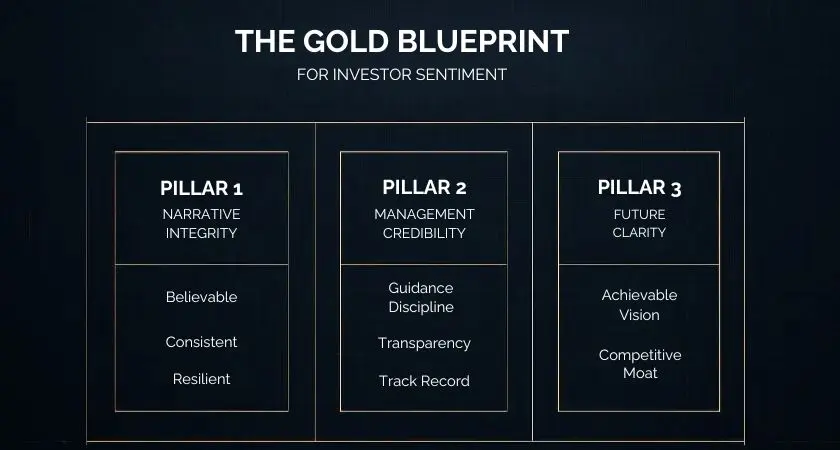Three consecutive earnings beats. Revenue growth ahead of guidance. A management team that delivers on every strategic promise. Yet your stock trades flat while competitors with inferior fundamentals command valuations that make your board question everything.
Sound familiar? You’re not alone—and you’re not victims of an “irrational market.” You’re experiencing the costly reality of unmanaged investor sentiment. Here’s how to take control.
The Undervaluation Enigma: When Strong Performance & Poor Sentiment Collide
After twenty years evaluating public companies as an institutional investor, I’ve witnessed this disconnect countless times. CEOs assume strong fundamentals automatically translate to positive investor sentiment. They deliver solid quarterly results, maintain clean balance sheets, and expect the market to reward their operational excellence.
The uncomfortable truth: mismanaged sentiment isn’t just a perception issue. It has a real dollar cost.
Investor sentiment directly impacts your valuation multiple, cost of capital, and strategic flexibility. A company trading at 12x earnings versus a peer at 18x isn’t just missing market recognition—it’s missing perhaps hundreds of millions in market cap and limiting future growth options.
Consider the hidden costs of poor sentiment management:
- Valuation discounts of 20-40% compared to peers with strategic narratives
- Increased stock volatility as confused investors trade on uncertainty
- Limited access to capital when growth opportunities arise
- Board pressure that escalates with each quarter of flat performance
- Management credibility erosion that compounds market skepticism
The most damaging assumption? That “the market will eventually figure it out.” In my experience, markets don’t reward patience—they reward clarity, consistency, and conviction. Companies that wait for fundamentals to speak for themselves often wait forever.
Investor sentiment isn’t an abstract concept. It’s a measurable, manageable strategic asset that directly influences whether your stock trades at a discount or premium to intrinsic value.

The Façade of Fundamentals: Why “Good Numbers” Aren’t Enough to Sustain Positive Sentiment
Here’s where most data-driven leaders get it wrong: they believe strong fundamentals alone will drive positive investor sentiment. Excellent financials are your ticket to the game, but they don’t guarantee investors will stay for the long haul, especially if the story isn’t there.
My critical insight from two decades of investment analysis: In the absence of a compelling narrative, investors default to scrutinizing quarterly numbers in isolation. Any perceived miss, even if minor, can trigger a sell-off because there’s no broader story to anchor their conviction.
I’ve seen companies with 20% revenue growth watch their stock drop 15% on an earnings miss of two cents. Why? Because investors had no narrative framework to contextualize the disappointment. Conversely, companies with strong, resilient narratives often see their stock hold steady—or even rise—during challenging quarters because investors believe in the long-term vision.
The three most dangerous “sentiment traps” I’ve observed:
The One-Hit Wonder: Companies that deliver strong quarterly results without establishing a sustainable story. Investors celebrate the beat, but sell on any sign of deceleration because they don’t understand the underlying drivers.
The Black Box: Operationally sound companies that perform well but remain mysterious to investors. Strong numbers with weak narrative create suspicion rather than confidence.
The Over-Promiser: Management teams that set aggressive guidance to “excite” investors, then struggle to deliver consistently. This destroys credibility faster than any single quarterly miss.
Without a compelling narrative, investors will scrutinize every data point in isolation rather than viewing quarterly results through the lens of a broader, believable story. As I often say, “A strong narrative provides the anchor that lets investors look past imperfect quarters because they’re playing the long game based on a story they believe in.”
The companies that master this distinction don’t just report numbers—they provide context, meaning, and conviction that transforms how investors interpret financial performance.

The “Investor Mind” Unveiled: Jason Gold’s Blueprint for Investor Sentiment
After evaluating thousands of management presentations and making buy-and-sell decisions with real money on the line, I’ve distilled the core psychological drivers of institutional investor sentiment into what I call “The Gold Blueprint for Investor Sentiment.”
This framework represents the three pillars that consistently determine whether sophisticated investors develop positive, lasting sentiment toward a company:
Pillar 1: Narrative Integrity & Investment Anchor
This goes far beyond “transparency” or “clear communication.” Narrative integrity means your story is believable, consistent, and serves as an investment anchor—providing context for quarterly numbers and reminding investors why they own the stock, especially when results fluctuate.
What investors really evaluate:
- Does the narrative make logical and emotional sense?
- Is it differentiated enough to justify a premium valuation?
- Can it withstand market volatility and competitive pressure?
- Does it provide a framework for understanding temporary setbacks?
The best narratives aren’t just compelling—they’re resilient. They help investors maintain conviction during inevitable challenging quarters by providing context that transforms “disappointment” into “temporary headwind within a larger success story.”
Pillar 2: Management Credibility & Predictive Reliability
Investors don’t just buy companies, they invest in management teams. Credibility isn’t built through charismatic presentations; it’s earned through consistent execution against stated expectations.
The credibility factors that matter most:
- Guidance discipline: Do you consistently meet or modestly beat your projections?
- Transparent communication: Are you candid about challenges before they become surprises?
- Track record consistency: Can investors trust your strategic promises based on past delivery?
- Crisis management: How do you communicate during difficult periods?
My “beat-and-raise” philosophy stems from this pillar. Setting conservative, achievable guidance and consistently exceeding it by a small, but reasonable margin creates a pattern of positive surprises that trains the market to expect good news. This expectation gets built into your valuation multiple.
Pillar 3: Future Clarity & Achievable Vision
Investors need to clearly understand not just where you’re going, but how you’ll get there and why they should believe it’s achievable. This requires translating complex strategies into clear, compelling long-term visions backed by defensible competitive advantages.
The vision elements that drive conviction:
- Strategic clarity: Is your path to growth specific and believable?
- Competitive moat: Do you have sustainable advantages that protect future returns?
- Market opportunity: Is your total addressable market large enough to justify growth projections?
- Execution roadmap: Are the steps to achieve your vision clear and measurable?
The framework’s power lies in its interconnection. A strong narrative without credible execution is just marketing. Reliable management without a compelling vision limits upside potential. Clear vision without narrative context creates vulnerability during setbacks.
When all three pillars align, you create what I call “sentiment resilience”—the ability to maintain positive investor perception even during temporary challenges.
The Operator’s Edge: Jason Gold’s Playbook for Proactively Shaping Investor Sentiment
Understanding investor psychology is half the battle; applying it from the inside is where real value is created. As a former public company Finance and IR lead, I can show you how to translate investor insight into concrete actions—from engineering narrative resilience to establishing guidance cadences that build bulletproof credibility.
Engineering Narrative Resonance That Anchors Belief
The strategic approach:
- Develop your core investment thesis in collaboration with key stakeholders. This isn’t marketing copy—it’s the fundamental reason investors should own your stock long-term.
- Test narrative resilience by stress-testing your story against potential challenges. Can it withstand a missed quarter, competitive pressure, or market downturn?
- Create narrative touchpoints throughout all investor communications. Every earnings call, investor meeting, and presentation should reinforce core story elements.
- Establish feedback loops with trusted investors to gauge narrative effectiveness and identify areas for refinement.
CEO Leadership Role: Champion the narrative consistently. Investors watch for alignment between what you say and how you allocate resources, time, and strategic focus.
Building Unshakeable Credibility Through Guidance Discipline
The systematic approach:
- Set conservative guidance below internal expectations based on realistic assumptions, not best-case scenarios.
- Communicate key variables that could drive upside without committing to specific outcomes.
- Beat that consistently while highlighting sustainable drivers of outperformance.
- Raise guidance incrementally based on demonstrated results, not projected optimism (will still leaving more room to beat these updated numbers).
- Maintain transparency during challenges by addressing issues head-on rather than hoping they resolve before disclosure.
CFO Leadership Role: Own the guidance process completely. Your financial communication must support the broader narrative while building track record credibility quarter by quarter.
This creates a virtuous cycle: consistent execution builds credibility, credibility reduces perceived risk, lower risk drives higher valuation multiples, and higher multiples provide strategic flexibility for growth investments.
Projecting Future Clarity Through Strategic KPI Selection
The alignment strategy:
- Choose KPIs that tell your story rather than just measuring performance. Metrics should demonstrate progress toward your strategic vision.
- Educate investors on KPI relationships so they understand how operational metrics connect to financial outcomes.
- Provide forward-looking context by explaining how current KPI trends support future guidance and strategic objectives.
- Maintain KPI consistency to allow investors to track progress over time and build confidence in your strategic execution.
The key is selecting metrics that not only demonstrate business health but also reinforce your investment narrative and build investor confidence in future success.

The Litmus Test: Maintaining Positive Sentiment Through Volatility & Special Situations
Any fair-weather IR plan can look good when markets are rising. The real test is maintaining investor trust—and your valuation—when headwinds hit. That’s where a sentiment strategy built on a resilient narrative and operational discipline proves its true worth, allowing investors to see past short-term noise.
Market-Wide Volatility: A strong, trusted narrative acts as an anchor during broad market selloffs. Investors with conviction in your story are more likely to hold or even buy during downturns if they believe in long-term value creation.
Company-Specific Setbacks: When you miss a quarter or face unexpected challenges, pre-established narrative credibility provides context. Investors can evaluate setbacks within the framework of your broader story rather than panicking over isolated events.
Activist Pressure: Strong pre-existing sentiment and clear strategic communication rooted in a compelling long-term story serve as powerful defenses against activist campaigns. Satisfied investors are less likely to support activist agendas.
M&A Activity: During integration periods or when deals fall through, maintaining narrative consistency helps investors understand how developments fit within your strategic vision rather than viewing them as random events.
The strategic advantage: Companies with robust sentiment frameworks don’t just survive these challenges—they often emerge stronger as weaker competitors stumble through poor communication and reactive management.
Crisis moments reveal which companies have truly engineered sentiment resilience versus those relying on favorable market conditions to mask underlying communication weaknesses.
Beyond Perception: Influencing Sentiment as a Cornerstone of Valuation
Investor sentiment isn’t magic; it’s methodical. By understanding the investor psyche, anchoring them with a compelling narrative, and applying proven operator strategies, you can move beyond simply reporting results to truly engineering the perception that unlocks your company’s full valuation—even when the waters get choppy.
The strategic imperative is clear: CEOs and CFOs who adopt this insider-led, narrative-first approach to investor sentiment are better positioned to achieve the market recognition and valuation their companies truly deserve.
Engineering positive sentiment, anchored by a resilient story, is a continuous process that underpins sustainable valuation and shareholder value. It provides stability when quarterly numbers fluctuate and confidence when market conditions deteriorate.
The companies that master this discipline don’t just communicate—they architect perception. They understand that sentiment is the bridge between operational excellence and market recognition. They know that strong fundamentals earn respect, but compelling narratives earn premium valuations.
The choice is yours: Continue hoping the market will eventually recognize your value, or take control of the narrative that shapes how investors perceive your future potential.
Your stock price isn’t just reflecting your current performance—it’s reflecting investor confidence in your ability to deliver on the story you’re telling. Make sure that story is worth believing in.
Ready to apply this insider playbook?
Explore how Jason Gold and Resurge IR provide the strategic counsel public companies need to engineer investor sentiment that drives sustainable valuation.
Schedule a consultation.
Frequently Asked Questions
Do these IR principles really apply to companies under $500M market cap?
Yes. Sophisticated investors use consistent evaluation criteria regardless of company size. The difference is that small and mid-cap companies often have fewer resources to execute these principles effectively, which is precisely why understanding them becomes even more critical. From my experience as an institutional investor, I evaluated companies the same way whether they had a $200M or $2B market cap—I looked for clear narratives, credible management, and consistent execution.
How long does it take to see results from strategic IR?
Initial credibility improvements typically take 2-3 quarters of consistent execution. Full valuation recognition usually requires 12-18 months. This timeline reflects the reality that investor confidence is built through repeated interactions and consistent performance, not one-time communications. As an investor, I needed to see management deliver on what they said multiple times before I fully trusted their guidance.
What’s the biggest IR mistake small-cap companies make?
Focusing on what their company does instead of why it matters to investors. I’ve seen countless management presentations that were essentially product demos rather than investment cases. Sophisticated investors don’t buy products—they buy growth prospects, competitive advantages, and management execution capabilities. The shift from “here’s what we do” to “here’s why this creates sustainable shareholder value” is transformational.
How do we know if our current IR approach is working?
Look beyond stock price to leading indicators: Are you getting meetings with institutional investors? Are analysts asking strategic questions rather than basic business model questions? Are you able to guide investor expectations accurately? From my investor days, the companies that impressed me weren’t necessarily the highest performers, but those whose management teams demonstrated clear strategic thinking and consistent communication.
What’s the difference between investor relations and public relations?
IR is about attaining fair valuation through transparent communication of financial performance and strategy, while PR focuses on broader stakeholder perception. IR professionals are legally obligated to provide balanced information—they can’t “massage” data or push stock prices. The goal is accurate investor understanding, not promotional messaging.
When should a public company engage an IR consultant?
Consider strategic IR consulting when: (1) Your stock trades at a significant discount to comparable companies despite strong fundamentals, (2) You’re not getting interest from institutional investors, (3) Your earnings calls consistently result in stock price volatility, or (4) You’re preparing for a major inflection point like an acquisition or new market entry. The best IR consultants are typically former investors or sell-side analysts who understand investor psychology.
How much should we spend on investor relations?
Fees vary widely: outsourced IR ranges from $5,000-$20,000/month, while strategic IR consulting ranges from $20,000-$50,000/month plus success fees. However, focus on ROI rather than cost. A strategic IR engagement that helps you achieve fair valuation can create tens or hundreds of millions in market cap value. Consider IR as an investment in your cost of capital, not just an expense.
What qualifications should we look for in an IR consultant?
Look for consultants with investor experience—former institutional investors or sell-side analysts who understand how investors evaluate companies. They should provide client references (not just firm references) and demonstrate specific experience with companies in your industry and market cap range. Avoid consultants who focus primarily on promotional tactics rather than strategic positioning.
Can good IR really impact our stock price?
IR doesn’t directly control stock price, but it significantly influences investor perception and confidence. Research shows companies hiring IR consultants see significant increases in press coverage, trading activity, institutional ownership, analyst following, and market valuation. The key is that IR helps ensure your stock trades at fair value relative to your fundamentals, rather than at a discount due to poor communication or investor misunderstanding.
How do earnings calls fit into overall IR strategy?
Earnings calls are quarterly tests of management credibility and strategic clarity. They’re not just financial reports—they’re opportunities to reinforce your investment narrative and demonstrate command of your business. The prepared remarks matter, but Q&A separates sophisticated management teams from those just going through the motions. Every tough question is a chance to reinforce your strategic narrative rather than just defend results.
What’s the most important thing for CEOs to understand about IR?
Your job isn’t to be liked by investors—it’s to be trusted and understood. This means being transparent about challenges, consistent in your messaging, and focused on long-term value creation rather than quarterly management. From my experience evaluating hundreds of management teams, the ones I trusted most were those who owned their mistakes, clearly articulated their strategy, and delivered what they promised.








